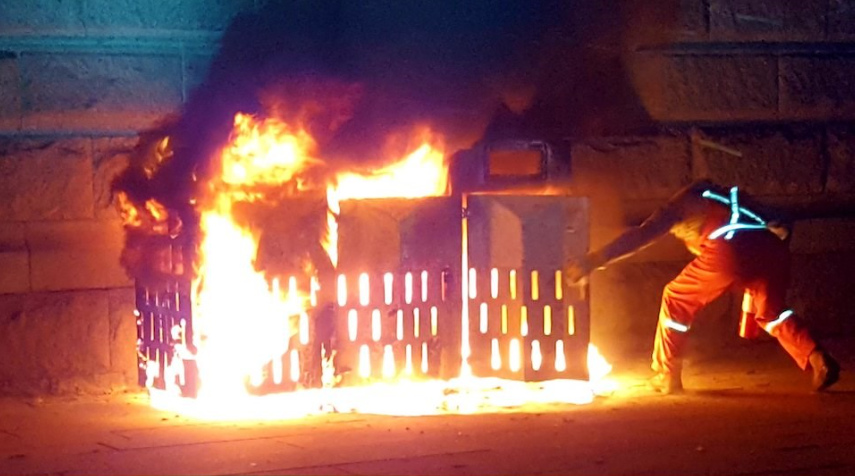Waste bins are often overlooked when it comes to fire prevention, yet they are responsible for a growing number of fires in offices, factories, and public areas. Everyday items like cigarette butts, lithium batteries, and flammable packaging can ignite unnoticed—leading to dangerous and costly incidents. What if fires could be stopped automatically, before they spread, and without electricity, sensors, or human action?
That’s the promise of passive fire suppression, and with FireXNull’s microcapsule-based technology, it’s not just possible—it’s practical.

Understanding Fire Classes in Waste Bins
Fire hazards inside waste bins fall into several NFPA fire classes:
- Class A: Ordinary combustibles (paper, cardboard, cloth, plastic). Most common in waste bins.
- Class B: Flammable liquids or gases (aerosols, solvents, oily materials).
- Class C: Energized electrical fires (possible in smart bins or compactors with power sources).
- Lithium-ion batteries: Not officially Class D, but a high-risk cause of ignition and re-ignition when damaged or crushed.
FireXNull’s technology primarily targets Class A and early-stage Class B fires—suppressing flames in seconds before escalation.
The Hidden Risk: Waste Bin Fires Are Rising
The EPA reported more than 240 lithium battery-related fires at U.S. waste facilities between 2013 and 2020. Similar reports have emerged worldwide:
- Refuse trucks have caught fire from crushed batteries and aerosols.
- Public areas have seen bin fires caused by cigarettes or faulty electronics.
- Indoor facilities suffer smoke damage long before flames are visible.
These events show why localized suppression inside the bin is crucial—preventing small fires before they become emergencies.
How FireXNull Passive Suppression Works
FireXNull’s system relies on microcapsule-based passive activation. Each microcapsule contains a clean extinguishing agent sealed within a heat-sensitive shell. When exposed to excessive heat, the capsules rupture and release the agent directly at the source of ignition.
FireXNull’s products such as FXN Tape and FXN Rope can be easily applied inside waste bins—on lids, rims, or side walls—where heat accumulates fastest.
Key Advantages:
- Works automatically—no electricity or sensors.
- Maintenance-free and residue-free.
- Safe for plastic and metal bins.
- Compact and easy to install.
Smart Installation for Safer Bins
To ensure optimal protection:
- Install FXN Tape or Rope along the underside of the bin lid or upper interior walls.
- Use short sections to cover multiple ignition zones.
- Avoid direct abrasion from liners or compactor mechanisms.
When heat reaches the activation threshold, the capsules rupture—releasing the extinguishing agent, cooling the area, and preventing flame spread. It’s clean, fast, and completely automatic.
Why FireXNull Works Where Others Don’t
Traditional extinguishers or aerosol systems are active solutions—they require detection, power, or manual activation. FireXNull’s system is passive, always on standby, and ready to act the instant heat rises. It provides:
- Residue-free suppression: No cleanup or corrosion after activation.
- Zero downtime: Systems remain operational post-incident.
- Eco-friendly materials: PFAS-free and compliant with modern safety standards.
- Energy independence: No power or maintenance required.
Sustainable Fire Safety for Modern Waste Systems
As cities evolve toward smart waste management, sustainability and automation go hand in hand. FireXNull’s passive fire suppression technology aligns perfectly with:
- Smart city infrastructure (sensor-based or compact waste stations)
- Battery recycling bins and industrial waste collection points
- Green building and LEED certification goals
Each FireXNull system provides a long-lasting, energy-free layer of protection, keeping facilities compliant, clean, and safe.
Best Practices for Facilities
Even with advanced suppression, safety starts with prevention:
- Never discard lithium-ion batteries or aerosols in regular bins.
- Use metal or fire-retardant bins in high-risk areas.
- Clearly label waste containers with disposal guidance.
- Combine FireXNull passive suppression with regular facility inspections.
Conclusion
Passive fire suppression for waste bins isn’t the future—it’s here today. FireXNull’s microcapsule-based system provides a smart, sustainable, and residue-free way to stop fires before they spread.
Protect your facility, reduce downtime, and eliminate messy cleanup—automatically.
FireXNull – Redefining fire safety with innovation, simplicity, and sustainability.
